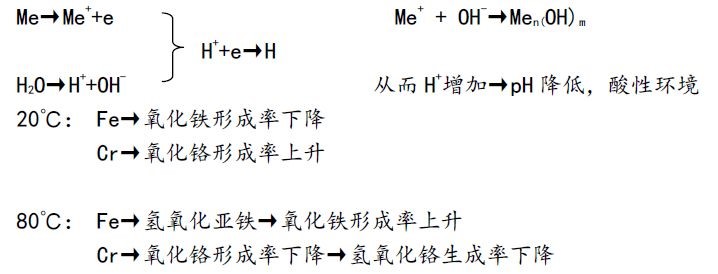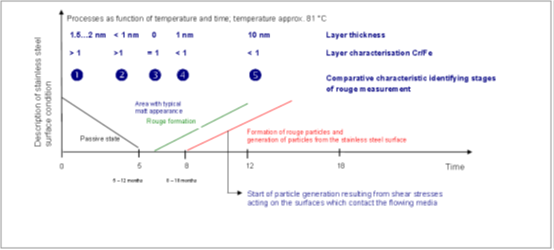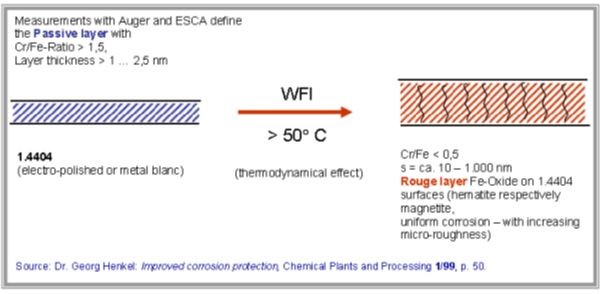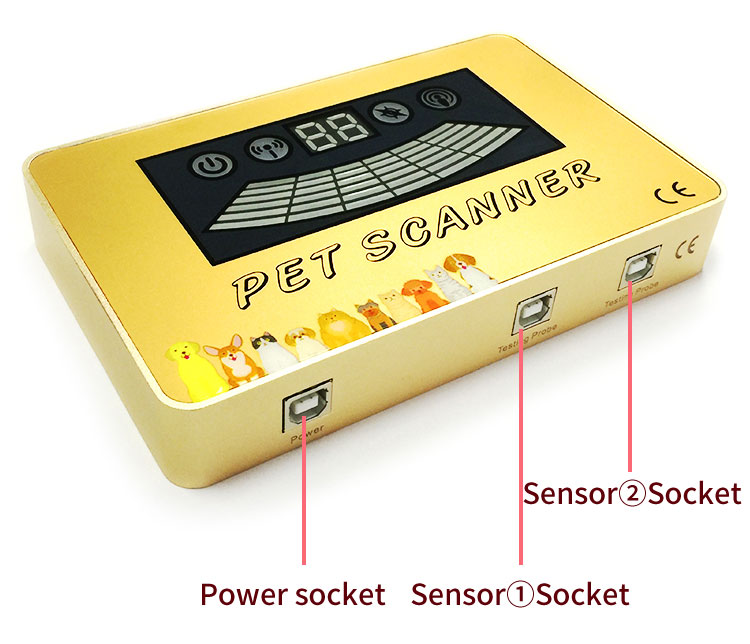[Technical Article] Quality Control of Online Red Rust Monitoring System in Water Injection System
Red rust generation in water for injection system In the pharmaceutical industry, water for injection systems are used to continuously provide high purity, high quality water for both experimental and production applications. In general, the water for injection is produced by distillation of a water injection machine, and is stored by a water storage tank for injection after heating. To prevent microbial growth, the water for injection system must continue to circulate in closed LOOP at > 70 °C . The pipe network material generally adopts 316L stainless steel or the same grade austenitic stainless steel, and the centrifugal pump is selected as the power device for the injection water circulation. Due to the extremely stringent requirements for the quality of water for injection, a series of online continuous monitoring units are usually installed in the water for injection system. These devices can promptly report the abnormal indicators appearing in the system and take corresponding measures. include: However, in recent years, the phenomenon of red rust generated by the water for injection system has been taken seriously. Usually, the system consists of 316L stainless steel and pipe fittings of the same grade austenitic stainless steel. After the formation of red rust, these heavy metal oxide (iron oxide) particles are injected. The formation and diffusion of water systems leads to pollution of water quality for injections, which is not detected by the above-mentioned online monitoring equipment. It can be seen from the experiment that the conductivity test can not detect the formation of red rust and the migration of red rust particles. As the current mainstream method for identifying red rust in the system is visual inspection (such as endoscopy), by visual inspection, local red rust film attached to the tube wall or red on the diaphragm valve gasket can be found. Rust deposition. However, the prerequisite for visual inspection is the need to shut down the system and remove the corresponding fittings. This method of detection is unsatisfactory due to factors such as time and efficiency. A ) When the water for injection system is heated, the temperature rise can cause changes in the water for injection: a. decrease in gas solubility - resulting in a decrease in dissolved oxygen levels in water for injection b. Significant increase in hydrolysis degree →H + +OH - or H 3 O+ OH - These changes have a profound effect on the destruction of the Cr 2 O 3 passivation protective layer and the formation of the Fe 2 O 3 secondary layer. Chromium and oxygen preferentially form chromium oxide instead of chromium hydroxide; iron, in contrast, preferentially produces ferrous hydroxide, which is easily dehydrated and then forms iron oxide, ie red rust. B ) Changes in composition corresponding to red rust: Can be seen from the two figures, ferrochromium ideal ratio is in the range of 1.5-2.0, with increasing temperature, about 40 ℃ ferrochromium decreased significantly than the start time, reaches a "qualitative" is about 60 ℃ i.e. The ferrochrome ratio is 1 , and after entering the running water temperature range, the specific drop begins to slow down and remains at a lower level of 0.3 . When the ferrochrome ratio is greater than 1.5 , the surface of the stainless steel tube wall retains a chromium-rich protective layer. When less than 0.5 , the red rust layer adheres to the original damaged chromium-rich layer. Usually in the running water temperature range, it is basically a large amount of iron oxide formed and the chromium oxide formation rate is extremely low. Under the influence of the red rust generation mechanism, the following reactions may occur in the system: The above description provides an explanation of the thermodynamic angle for the irreversible transition of the wall surface from the chromium-rich protective layer to the iron oxide secondary layer. Although iron oxide ( Fe 2 O 3 , Fe 3 O 4 ) has very low solubility in water, iron hydroxide and ferrous hydroxide have higher solubility than iron oxide, and iron hydroxide dissolves in (injected) water. The flow provides a possibility for the diffusion of red rust. Red rust monitoring concept The formation of red rust greatly changed the structure of the initial stainless steel tube passivation film, and the permeable and corrosive iron oxide secondary layer adhered to the impermeable and stable chromium oxide passivation protective layer. This figure shows the change of the surface of the pipe wall after the formation of red rust. The surface of the stainless steel pipe wall of the electric planer retains a chromium-rich protective layer with a thickness of 2.5 nm and a ferrochrome ratio of more than 1.5 . It is used in water for injection, and the ratio of ferrochrome to iron Reduced to less than 0.5 , the red rust layer adhered to the original damaged chromium-rich layer, the thickness of 10-1000nm ! The red rust secondary layer is analyzed by ESCA photoelectron spectroscopy and Auger electron spectroscopy. The layer is mainly composed of oxide particles of divalent iron and ferric iron which are extremely insoluble in water. In addition, in the secondary layer A certain amount of chromium, nickel and molybdenum elements were also found. According to the research so far, the particle size distribution of the red rust secondary layer is between 0.01 and 5 μm , and thus is visible. These particles can be qualitatively and quantitatively analyzed by filters or precision measurements such as laser particle counters. Typically these granules are present in the water for injection in an amount of from 30 to 60 mg per liter. Although these data are far below the lower limit of the pollution index specified in the United States Pharmacopoeia ( USP ) 26 , monitoring of these data is still very important. Cognitive concept of red rust When it is realized that red rust does appear in the system, it can be assumed that the system (new / reform / overhaul) initially has a perfect chromium-rich passivation film and fluid medium contact. Over time, the chemical equilibrium of the ideal initial passivation film is gradually disintegrated, the protective layer is slowly destroyed, and the secondary layer of iron oxide is produced. This process is often accompanied by a series of changes in the performance of the inner wall of the wall: Based on these changes, the red rust monitoring system should be included in the list of mandatory testing units for the water for injection system, which has the ability to identify the various changes described above and to enable the process of red rust generation to be described. In view of the red rust formation mechanism mainly affected by temperature, it can be understood as: the disintegration of the slow chromium-rich passivation layer, the formation of the iron oxide secondary layer and the formation of a full-corrosion layer of red rust particles. We can assume red rust particles (hazard The formation and migration of the extremely large is based on the formation of the secondary layer of iron oxide. Therefore, it is very valuable to be able to display the detection mechanism of the whole process in a timely and accurate manner, which helps to develop a coping strategy at a good time. As seen from the above figure, the initial thickness of the stainless steel passivation film is 1.5-2nm , and the ferrochrome ratio is greater than 1 ; As time goes by, the thickness of the chromium-rich layer becomes thinner, and when the running time is about 5 months, it is gradually less than 1 nm , and the ferrochrome ratio is slightly decreased, but still greater than 1 ; (the actual occurrence period is 5-12 months); When the operation is about 6 months, the chromium oxide component film on the stainless steel surface disappears, forming independent chromium oxide and iron oxide components. The secondary layer of iron oxide begins to form, and the ferrochrome ratio is 1 ; By 8 months, the thickness of the secondary layer reaches 1 nm . With the accumulation of iron oxide and the contact stress between the surface of the tube wall and the fluid, visible macroscopic iron oxide particles appear to appear, and the ratio of ferrochrome to less than 1, ( The actual occurrence period is 8-18 months) After running for 12 months, the red rust particles have a certain amount of distribution and migration, the red rust secondary layer thickness reaches 10nm , and the ferrochrome ratio is less than 1 . The above red rust formation and migration process map is realized by particle counting and filtering technology. However, the particle counter can only provide data information about the particle number, and can not provide information about the particle type, nature and composition; residual filtering technology can distinguish Particle types (such as iron oxide particles and silicon particles) help. With the above various monitoring and measuring methods, it is possible to accurately detect the formation of red rust, determine the formation time of red rust particles, and make an effective response strategy in time. Therefore, we believe that the red rust monitoring system should be included in the ranks of the necessary testing unit for the water for injection system to provide real-time monitoring for the generation of red rust, confirm the system rust removal cycle, to avoid the occurrence of quality accidents caused by water quality pollution of injection water.
What is the pet scanner?
[Pet Scanner] involves high-tech innovation projects of medicine, bio-informatics, electrical engineering and other sciences. Using the quantum medicine as the theoretical basis, it applies the advanced electronic equipment to collect the weak magnetic field of animal cells for scientific analysis, thereby analyzing and determining the tested animal's health status and main problems and
putting forward standard prevention recommendations. [Pet scanner] is individualized guide of health care consultation for full animal body and forward health science, and has the advantages of completeness, non-invasiveness, practicality, simplicity, fastness, economy, easy popularization, etc. With the depth and development of scientific research, it will make a greater contribution for the cause of animal health, having a broad development and application prospect.
Principle of quantum analyzer:
The animal body is the aggregates of a large number of cells which are in continuous growth, development, differentiation, regeneration and apoptosis, and the cells constantly self-renew through its own division. In the process of cell division and growth, those charged bodies of atomic nucleuses constituting atoms as the basic unit of cell and the electrons outside the nucleus are in constant high-speed movement and changing, thereby constantly emitting electromagnetic waves.
The electromagnetic wave signals emitted by the animal body represent the specific state of the animal body, and the emitted electromagnetic wave signals are different under the different conditions of the human body, such as health, sub-health, disease, etc. If we can determine these specific electromagnetic wave signals, we can determine the status of the body's life.
Quantum medicine considers that the most fundamental reason of falling sick is that the spin of electrons outside the atomic nucleus and the orbit change, thereby causing the change of atoms constituting a material, the change of small biomolecules, the change of big biomolecules, the change of all the cells and finally the change of organs. Because the electron is a charged body,
when the spin of electrons outside the atomic nucleus and the orbit change, the electromagnetic wave emitted by the atoms will change. The energy o f the electromagnetic wave changes caused by the changes of the animal body's diseases and physical changes in the nutritional status is extremely weak and usually is only nano gauss to microgauss. The frequency and energy of the
weak magnetic field of hair determined directly or by holding a sensor compare with the resonance spectra of standard quantum of diseases and nutrition indicators set in the instrument after the frequency and energy are amplified by the instrument and processed by the computer, and then the corresponding quantum value being from negative to positive is output. The size of the
quantum value indicates the nature and extent of the disease and the nutrition levels. Finally, the test results are resolved by clinicians. It's similar to the principle of listening to broadcasting from the radio. There are many radio waves in the air. If you want to listen to some designated broadcasting, you can transfer the radio to the corresponding frequency, at this moment, resonance occurs, so that you can listen to this broadcasting. Quantum resonance uses this principle for testing.
Animal Quantum Analyzer, Dog Quantum, Cat Quantum Shenzhen Guangyang Zhongkang Technology Co., Ltd. , https://www.syztreatment.com







